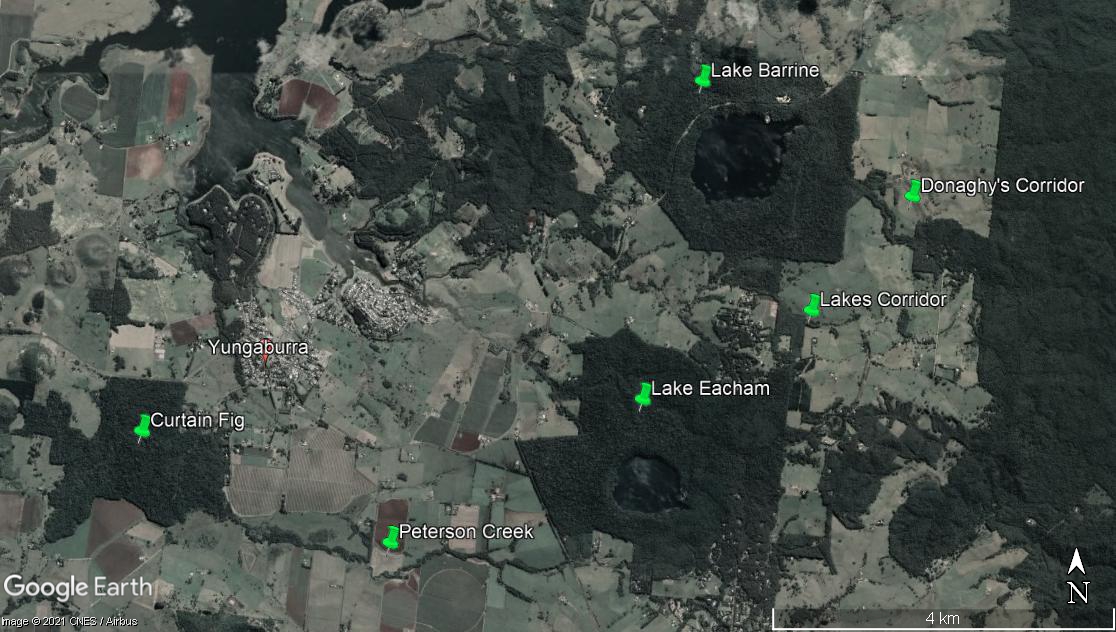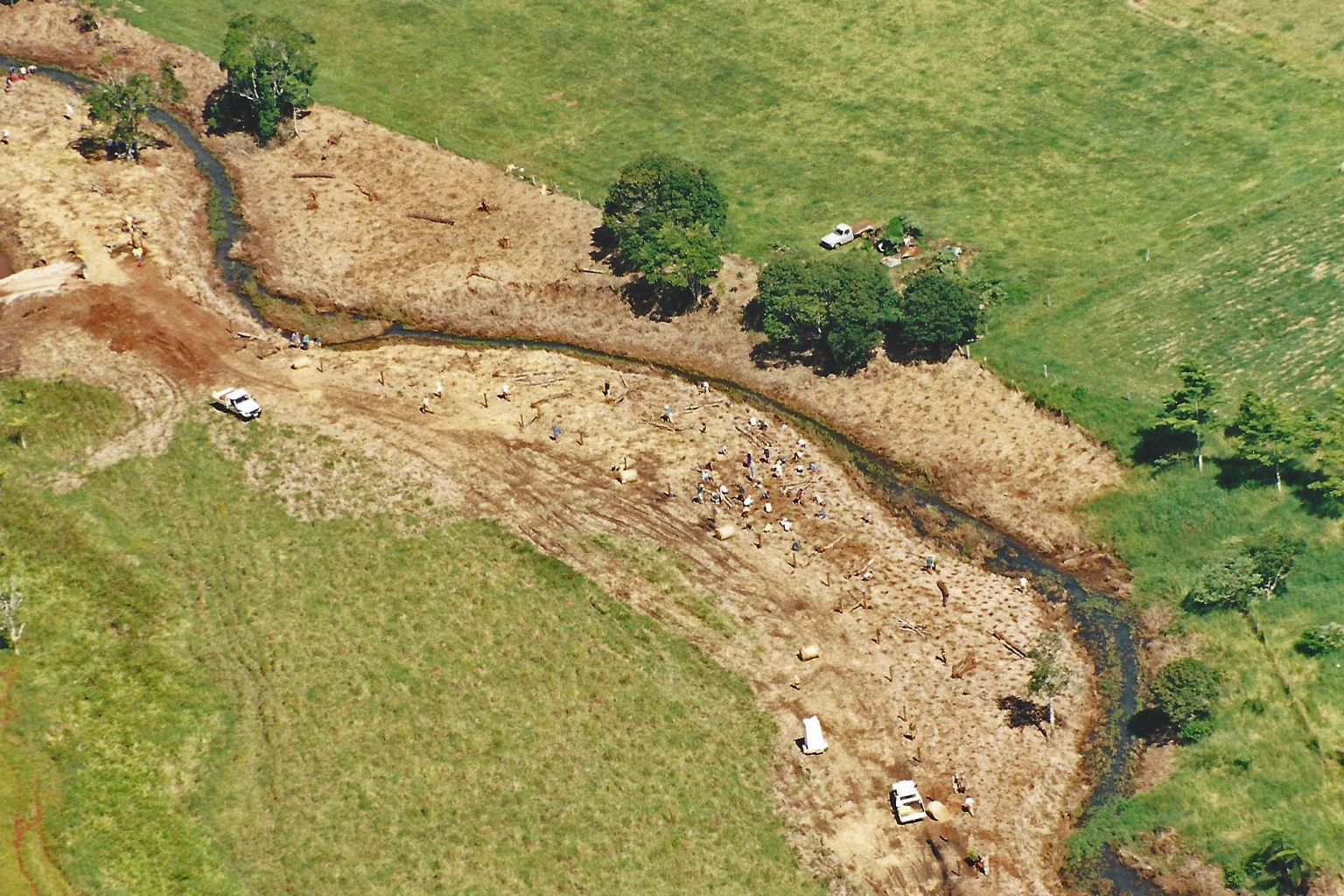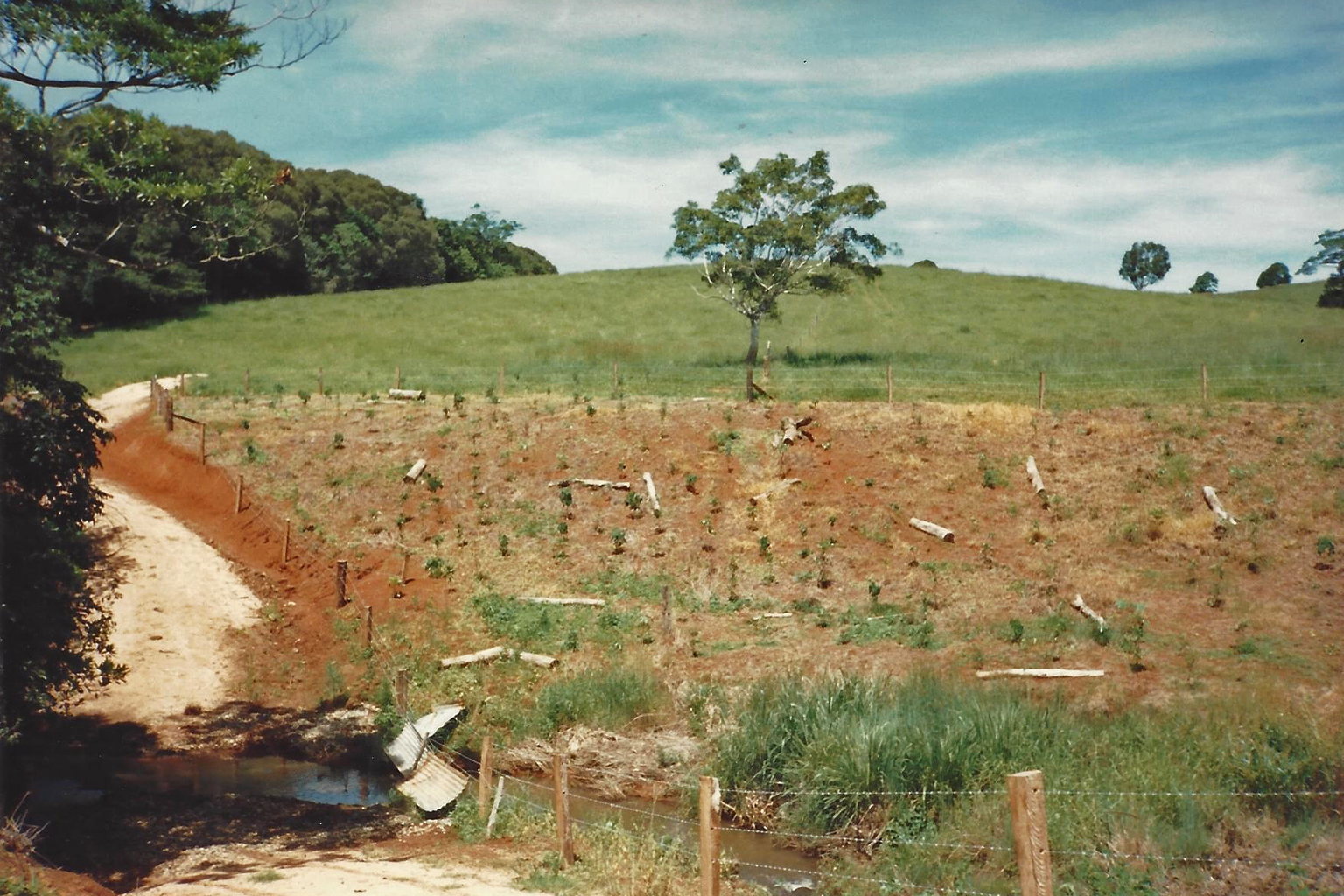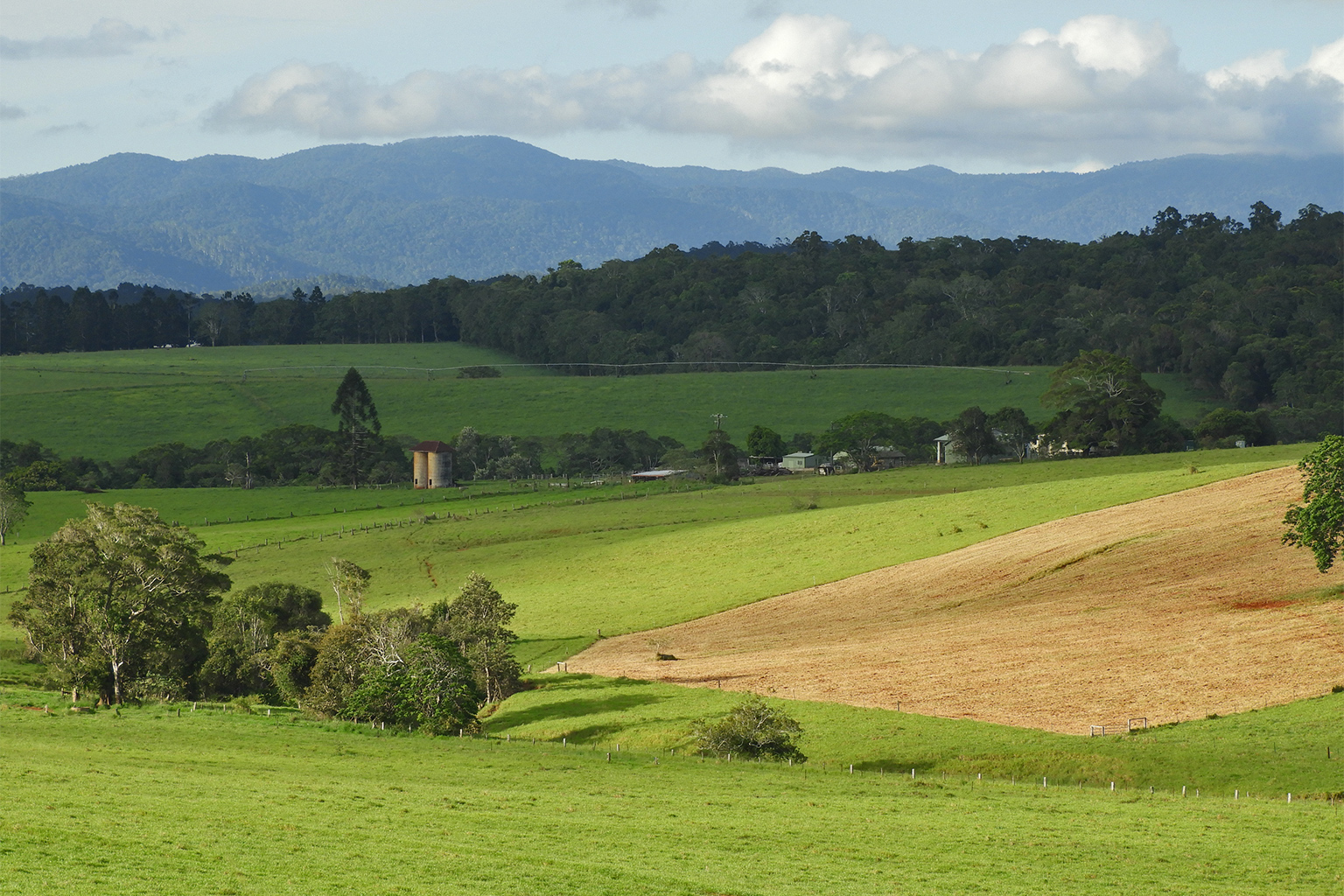- Corridors of planted rainforest trees — landscape linkages — are a straightforward, but costly, on-ground action that can repair past damage and bolster ecosystem resilience in Australia’s Wet Tropics region.
- In the Atherton Tablelands wildlife corridors, now in their third decade, the diversity of naturally regenerating plant species has increased, with trees, vines, rattans, shrubs, palms, ferns and orchids colonizing the planted sites.
- The corridors are providing connectivity and additional habitat for a range of rainforest wildlife, including some threatened by climate change.
- To thoroughly measure the biodiversity outcomes of the linkages, monitoring would need to be more regular, and target a broader range of taxa.
The tooth-billed bowerbird gave itself away with a not-quite-right call. Suspicious, I’d panned my binoculars toward the sound and there he was, the mimic, high in the canopy of a rainforest tree. It was a satisfying sight.
Like many of Australia’s wet tropics-endemic species, tooth-billed bowerbird populations have declined rapidly in recent years, their climate change-induced retreat to higher elevations acknowledged in Birdlife Australia’s new Action Plan for Australian birds.
It was not just seeing this charismatic bird that was so satisfying, however, but where it appeared. It wasn’t found in a survey in a large expanse of World Heritage-listed rainforest. Or even in remnant forest surrounding the Atherton Tablelands’ famous Crater Lakes.
It was in a 25-year-old rainforest restoration site in Donaghy’s Corridor, a 1-kilometer (0.6-mile) linkage of planted habitat.
The tooth-billed bowerbird shows that the linkage is working, at least for some species.

Landscape linkages: ‘Acts of faith’
Stretching hundreds of kilometers along Australia’s northeast Queensland coast, the Wet Tropics includes nearly 800,000 hectares (2 million acres) of World Heritage-listed tropical rainforest and is one of the country’s most biodiverse regions.
Donaghy’s Corridor, the Peterson Creek wildlife corridor and the Lakes Corridor are a network of rebuilt forest linkages joining the otherwise isolated Lake Eacham, Lake Barrine and Curtain Fig national parks, each 300-500 hectares (700-1200 acres), to Wooroonooran National Park. At nearly 80,000 hectares (200,000 acres), Wooroonooran is one of the largest continuous forest blocks in the Wet Tropics World Heritage Area.
Located near the small town of Yungaburra, on the Atherton Tablelands, the three habitat linkages were “acts of faith” when they got underway in the 1990s. They were a response to past land clearing and forest fragmentation, but nobody had proof they would assist wildlife.
By the 1990s, metapopulation theory was beginning to influence conservation management. The theory implied that restoring habitat and reconnecting forest fragments would reestablish movement and gene flow between species’ populations and maintain biodiversity. But when Donaghy’s Corridor began in 1995, it was largely untested.
“I guess all I was really thinking about was joining up an isolated reserve with a continuous forest,” said Nigel Tucker, director of environmental consultancy Biotropica Australia.
It was Tucker, then manager of the Queensland Parks and Wildlife Service’s (QPWS) Lake Eacham Nursery, who approached the Donaghy family about planting a wildlife corridor on their land, and mobilized QPWS state agency staff and community volunteers to grow, plant, and maintain the trees, and then to monitor the outcomes.


TREAT the landscape
Volunteer tree-planting organization Trees for the Evelyn and Atherton Tablelands (TREAT) is on the front line of the Atherton Tablelands rainforest restoration efforts. Established 40 years ago, and with more than 400 participating households, TREAT partners with QPWS to produce trees for rainforest restoration projects.
On a recent visit to the QPWS Lake Eacham Nursery, 50 TREAT volunteers were busy preparing seed and potting seedlings ready for future plantings. A hundred people can turn out to community tree-planting days, where a few thousand trees may be planted in just a couple of hours.
The nonprofit says collaboration is a core element of its work.
“Number one is the relationship between the Queensland government [QPWS] and TREAT,” Angela McCaffrey, TREAT’s president said, in an interview. “The fact that we have their support, and that there are full-time staff looking after the trees during the week, that we don’t even have to think about or worry about.”
It has indeed proven to be a productive synergy.
Both the Donaghy’s and the Peterson Creek wildlife corridors are products of the partnership. QPWS planned and prepared the planting sites, TREAT and QPWS raised the seedlings at the Lake Eacham Nursery, and TREAT volunteers planted them.
Similarly, the Lakes Corridor was completed by the North Johnstone and Lake Eacham Landcare Association, another community organization, with assistance from the Tablelands Regional Council.


Working with landholders is also vital, McCaffrey told me.
“We’re not out to revegetate all the available land on the Tablelands,” McCaffrey said. “We look for strategic areas that can link up remnants. We work with farmers, and offer things like water quality improvement, creek bank stabilization, and shade for livestock — many things that are positive for the farmer. It’s not just about taking land off them and revegetating it for the wildlife.”
It’s an approach that has gained international recognition. The Global Restoration Network listed the three corridors, under the collective name Southern Atherton Tablelands wildlife corridors, in Australia’s Top 25 restoration projects for 2000-2010.
Government and community organizations have adopted rainforest restoration as practical action that can repair past damage and bolster ecosystem resilience.
But it’s expensive.
Biodiversity plantings, like those making up the corridors, use a diverse mix of advanced native tree seedlings and typically need two to three years of herbicide treatment before the canopy closes, weeds are suppressed, and maintenance crews can walk away.
Estimates for biodiverse rainforest planting on the Atherton Tablelands average around $10,000 per acre, or $25,000 per hectare. The three corridors have, between them, had more than 180,000 trees planted over more than 50 hectares (120 acres) and cost in excess of $1.2 million.


Biodiversity bang for the buck
Most plantings in the three Atherton Tablelands wildlife corridors are in their third decade. The U.N. Decade on Ecosystem Restoration (2021-2030) has motivated researchers and restoration practitioners to examine whether the developing linkages have improved habitat and connectivity for wet tropics flora and fauna. They want to know the biodiversity bang for the buck.
Most is known about Donaghy’s Corridor. Plant, bird and mammal communities have been surveyed here in 2021 and compared with baseline data collected during the corridor’s establishment phase. Less is known about flora and fauna in the Peterson Creek and Lakes Corridors, and there haven’t been any recent systematic surveys.
In the recent surveys of Donaghy’s Corridor, Biotropica Australia’s Tucker and fellow plant ecologist David Tng say they’ve found that the diversity of naturally regenerating plant species has doubled since 2000.
A variety of trees, vines, rattans, shrubs, palms, ferns and orchids have all colonized the planting sites, say Tucker and Tng. Significantly, the number of species with large fruits has doubled.
“It’s not just the number of species, it’s the species themselves,” Tucker said. “Hairy walnut [Endiandra insignis] and yellow walnut [Beilschmiedia bancroftii] — they’re plants of intact forest. They’re not plants of regrowth or secondary forest.”

Despite comparable plant species diversity, and vertical layers of vegetation giving a rainforest-like appearance, however, the composition of the planted corridor still differs from primary forest. It may be centuries before they converge.
Most rainforest trees and shrubs bear fleshy fruits whose seeds are dispersed by mobile vertebrates, especially birds. Frugivorous birds are therefore crucial to ongoing regeneration, and development of more complex forest, in restoration sites. Eight key frugivores have been recorded in Donaghy’s Corridor during the 2021 bird surveys. These include highly mobile figbirds, fruit-doves, bowerbirds, and the migratory channel-billed cuckoo, which can disperse medium-large rainforest fruits. Four species with mixed diets are also contributing to seed dispersal.
Back then, no rainforest specialist species were using the planted sections of the corridor. In 2021, there are 19. Among them are 13 species that have declined at mid-elevations due to climate change. Some, like the Wet Tropics brown gerygone (Gerygone mouki mouki), used to be considered common and resilient. Its decline has been so dramatic that the subspecies is now considered endangered.
Donaghy’s Corridor also boasts four endemic species: the gray-headed robin (Heteromyias cinereifrons); pied monarch (Arses kaupi); tooth-billed bowerbird (Scenopoeetes dentirostris); and Victoria’s riflebird (Ptiloris victoriae), the region’s only bird-of-paradise. Four other endemics, which occur in the forests at either end of the corridor, are absent.
Cassowaries (Casuarius casuarias), large and flightless, are also conspicuously absent. They’re versatile frugivores with distinctive, seed-loaded scat. The patches of seedlings germinating in their “plop and grow” potpourri piles are calling cards for their disperser long after the bird has moved along.
There’s been no sign of these calling cards in the corridor to date.

Originally aspiring to be a “cassowary corridor,” Donaghy’s Corridor has yet to deliver on this early promise. The large-seeded recruits found by Tucker and Tng have been dispersed there by giant white-tailed rats (Uromys caudimaculatus). These rodents, weighing up to 1 kilogram (2.2 pounds), consume rainforest seeds. Sometimes, though, they forget their cached meals, leaving the seeds to germinate.
Tucker has caught them on his camera traps throughout Donaghy’s Corridor.
“Undoubtedly they’re predating a stack of things as well,” Tucker said. “But the number of times that something like hairy walnut germinates in the corridor shows that their scatter-hoarding behavior is a functionally important part of restoration in this environment. Seed size means that they’re the only species which could be doing that.”
Giant white-tailed rats, along with bush rats (Rattus fuscipes) and Cape York rats (Rattus leucopus), were quick to colonize Donaghy’s Corridor. Tucker and his co-workers detected them only three years after the linkage was complete.
In 2021, they’re still there, among an assortment of small ground-dwelling mammals that are relatively unchanged since those early surveys. There are rodents, bandicoots and echidnas, but still no sign of red-legged pademelons (Thylogale stigmatica) or musky rat-kangaroos (Hypsiprymnodon moschatus), the smallest and most primitive member of the kangaroo family.

Bird communities in the Peterson Creek wildlife corridor were last surveyed in 2015-2017. At that time, there were already considerable changes since the previous surveys in 1999-2005 when the corridor was being established. More rainforest-dependent species had moved in, including four wet tropics endemics. Whereas no fruit pigeons or bowerbirds were recorded in the earlier surveys, catbirds, wompoo fruit doves (Ptilinopus magnificus) and superb fruit doves (Ptilinopus superbus) had moved in by the later survey rounds.
Over at Lakes Corridor, a 2016 study of bird communities found that the species of birds using the linkage differed substantially from those next door in the fragments. But several rainforest-dependent species were using the corridor, and, as at Peterson Creek, four wet tropics endemics were detected there too.
Rainforest rodents were slower to colonize the Peterson Creek plantings than they were at Donaghy’s Corridor, presumably because the 5-km (3.1-mi) strip of streamside vegetation between Lake Eacham and Curtain Fig is a considerably longer linkage.
There is no update on ground-dwelling mammals, but tree climbers are making a comeback, according to locals.
Simon Burchill, whose family hosts the corridor on their property at the lower end of Peterson Creek, reported in TREAT News that he regularly sees Lumholtz’s tree-kangaroos (Dendrolagus lumholtzi), including adult females with joeys. Coppery brushtail possums (Trichosurus johnstonii) and green ringtail possums (Pseudochirops archeri) are also regularly seen.


Water watch
The three Atherton Tablelands wildlife corridors all incorporate waterways; cool, moist places where fauna often concentrate. Aquatic species benefit too, as streamside vegetation creates shade and reduces bank erosion.
Key to establishing streamside vegetation in the Peterson Creek and Donaghy’s Corridors, where cattle graze adjacent, has been fencing cattle out and installing off-creek watering. This has been a win-win for fauna and farmers.
“We’ve no regrets,” Patrick Donaghy said in a phone interview of the water troughs on his family’s farm. “They’re the best thing ever. You see the job they do for the water and the stream banks, by getting the cattle out, and it all makes sense.”
Residents and visitors have benefited too.
At Allumbah Pocket near Yungaburra, the Yungaburra Landcare Group has continued the Peterson Creek wildlife corridor downstream into the peri-urban area. It has transformed the stream banks, previously overrun with exotic grasses and lantana, into wildlife habitat — and a popular place to look for tree-kangaroos and platypuses.

Signs of success
When it comes to rainforest restoration, success is incremental. For McCaffery, success comes with planted trees being used.
“I can remember seeing a fruiting lilly pilly [Syzygium smithii],” she said. “Absolutely loaded with beautiful purple fruit. There were tooth-billed bowerbirds, wompoo fruit doves, catbirds and brown cuckoo-doves [Macropygia phasianella]. The whole tree was alive and moving with birds. It was staggering to see so much activity. That tells you that that tree has been a success.”
For Tucker, success, if achieved, will come later.
“Birds, bats, big rats — they’re fairly mobile,” he said. “The real measure of success will be things like possums, and rainforest reptiles and amphibians. The less mobile specialists.”
But with limited resources, and so many possible aspects to measure, monitoring in the wet tropics has seldom targeted these logistically more challenging groups. In some respects, rainforest restoration is still an act of faith, based on the assumption that “if you build it, they will come.”
They may not.
“You can’t extrapolate and say that once you’ve got the ecological generalists, that the ecological specialists will follow,” Tucker said. Monitoring would need to be more regular, and target a broader range of taxa, to thoroughly measure the biodiversity values against the funds invested.
Those values will change through time. “Nobody can plant a rainforest,” McCaffrey said. “You can only plant the structure, the trees that you think will speed the process up, get all those transformations happening.”

Disclosure: Amanda Freeman plans to publish the 2021 Donaghy’s Corridor survey along with Nigel Tucker and David Tng, two of the researchers cited in this article. She is also the co-author of a 2009 paper on an earlier bird survey, cited here. Her household is a financial member of TREAT and participates in voluntary community tree-planting days.
Banner image: A Victoria’s riflebird. Image courtesy of Amanda Freeman.
Citations:
Opdam, P. (1991). Metapopulation theory and habitat fragmentation: A review of holarctic breeding bird studies. Landscape Ecology, 5(2), 93-106. doi:10.1007/bf00124663
Jansen, A. (2005). Avian use of restoration plantings along a creek linking rainforest patches on the Atherton Tablelands, North Queensland. Restoration Ecology, 13(2), 275-283. doi:10.1111/j.1526-100x.2005.00035.x
Williams, S. E., & De la Fuente, A. (2021). Long-term changes in populations of rainforest birds in the Australia Wet Tropics bioregion: A climate-driven biodiversity emergency. doi:10.1101/2021.07.23.453540
Tucker, N. I., & Simmons, T. (2009). Restoring a rainforest habitat linkage in North Queensland: Donaghy’s Corridor. Ecological Management & Restoration, 10(2), 98-112. doi:10.1111/j.1442-8903.2009.00471.x
Dennis, A. J. (2002). The diet of the musky rat-kangaroo, Hypsiprymnodon moschatus, a rainforest specialist. Wildlife Research, 29(2), 209. doi:10.1071/wr00052
Freeman, A. N., Freeman, A. B., & Burchill, S. (2009). Bird use of revegetated sites along a creek connecting rainforest remnants. Emu — Austral Ornithology, 109(4), 331-338. doi:10.1071/mu09089
Heise-Pavlov, S., Rhinier, J., & Burchill, S. (2017). The use of a replanted riparian habitat by the Lumholtz’s tree-kangaroo (Dendrolagus lumholtzi). Ecological Management & Restoration, 19(1), 76-80. doi:10.1111/emr.12282
Hilderbrand, R. H., Watts, A. C., & Randle, A. M. (2005). The myths of restoration ecology. Ecology and Society, 10(1). doi:10.5751/es-01277-100119
